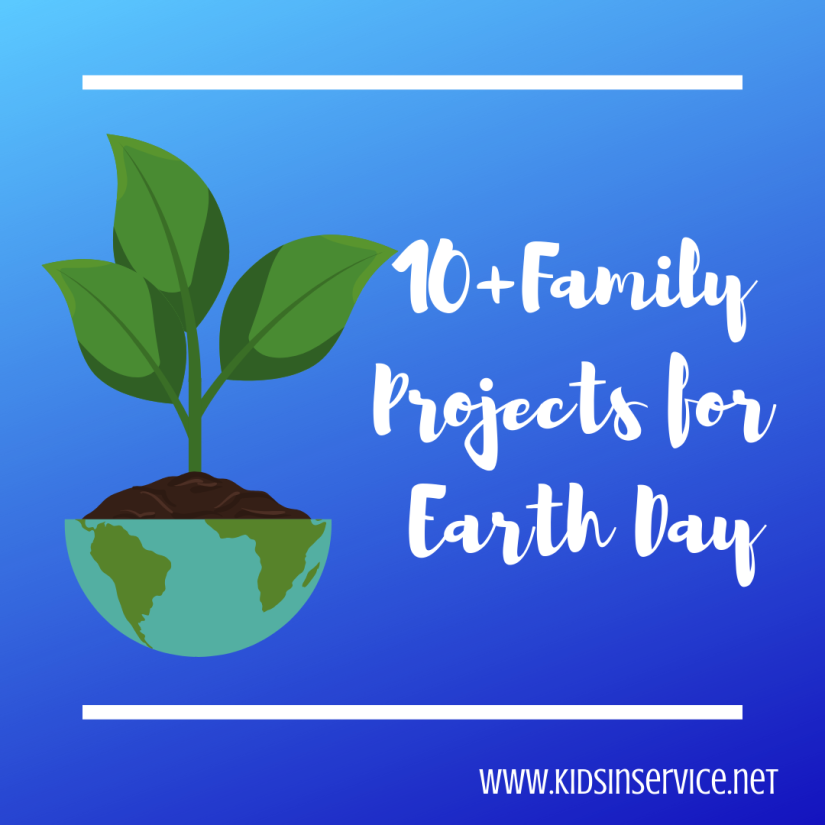
Kids in Service is focusing on the planet for the month of April. Today we are sharing projects that you and your family can do together to help the earth. Some of the projects are very simple and can be done in under an hour and a few are a bit more complex.
We hope the following projects inspire you and your family to do something for our planet this month. Happy Earth Month!
1. Participate in Screen-Free Week
Every year my family participates in a Screen-Free Week, which is usually happens in the beginning of May. This week not only conserves energy but it encourages the entire family to spend the time they would be using screens in more creative ways. The kids (and I) always dread these weeks but they end up being really great. We spend more time outside, play lots of board games, read and listen to audio books and spend a lot of time on creative projects. Before the week begins we brainstorm a list of ways to spend our screen free time and post this on our television. This acts as a reminder to keep screens off. The first two days are the hardest but after awhile you all will find ways to fill that screen free time. Click Here for more info and to register.

This is a great project for ALL ages! I have participated in this project a few times and it is a lot of fun. If your local grocery store has paper bags, talk to a manager about borrowing a stack to decorate for Earth Day (April 22nd). Decorate the bags with Earth Friendly messages and pictures. Return the bags before Earth Day so that the stores can use them for groceries on Earth Day. This is a great project to do as a family, with friends, as a project in your child’s classroom or with Brownies or Cub Scouts. Click HERE to learn more.

Miss Rumphius is one of my favorite Children’s books and this project allows you and your family to make the world a more beautiful place, just like she did. This guerrilla gardening project helps to plant native flowers in places that could use a bit of love. Perhaps you have a vacant lot in your neighborhood, or the local road or highway needs some brightening or maybe you want to use these in your own backyard. They are easy to make and take no care once they are spread. Here is what http://www.gardeningknowhow.com had to say about how easy this project is: “The last step in how to make flower seed balls is sowing them. Yes, you can place them carefully over the area to be planted or you can gently toss them one at a time, which is a lot more fun. Don’t bury them and don’t water them.–gardeningknowhow.com” Click HERE to learn how to make your own Native Seed Balls or you could buy THESE.
4. Park or Neighborhood Clean Up
Grab some gloves, some trash bags and head out to clean up your street or park. We live in the Northeast and when the snow melts, the roads and parks are a mess. April is a wonderful time to go out and clean up your local spaces. I have had children as young as two years old participate in trash clean ups. The key to this project with children is to clean up a safe space (parks are great), have them wear non-latex gloves and make sure you have plenty of adult supervision.
Litterati is a way to get the the older kids excited about cleaning up trash. Literrati is an app that tracks your trash clean up and the types of litter you find and is found around the world. The company then organizes the data they collect and work with big brands to find more sustainable production methods.

5. Conserve Energy at Home
It is easy to save energy as a family by putting a few new rules and routines in to place. Sit down as a family and discuss all the ways that energy is used in the house. If the kids are old enough, share your latest electric and/or heating bills. Discuss places where energy may be wasted (lights, heat, AC, electronics being plugged in, long showers etc.) and brainstorm solutions to help conserve. Set a family goal, “If we save on energy costs this month, we can go on a family bike ride, bowling or have pizza on the beach etc.” Visit this website for 31 Tips on how to conserve energy in your home.
6. Backyard Wildlife Habitat Project
If you enjoy animals visiting your backyard, you can provide a few key things to help with their survival. Just like humans, the animals in your yard need food, shelter, water and space to raise their young. CLICK HERE and HERE for steps on how you can create your own backyard wildlife habitat.

7. Reduce Plastic Use
All over the world, countries are working to reduce their use of plastic. Plastic bags and straws are being banned and people are working to find alternate solutions to plastic. According to National Geographic, every year between 5 million and 14 million tons of microplastic flow into our ocean from coastal areas. These tiny particles of plastic are being consumed by fish, marine birds and whales. These plastics collect in their systems and can attract harmful chemicals which then transfer into the muscles of the fish (the parts that humans consume). Plastics have been found in great numbers 2,000 miles off shore. It is up to us to take this issue seriously and help future generations by forming new habits now. Click HERE for 51 ways to reduce your use of plastic at home and on the go. Click HERE to learn about how one African village transformed their plastic trash problem into treasure. You can also learn how to make your own handbag out of plastic bags!

8. Donate Gently Used Toys, Games and Clothes
People who are homeless are always in need of gently used clothing (especially warm clothing in the cold winter months), new toiletries or toys that are in good shape. Give everyone in your family a bag or a box and challenge them to fill it with as many quality items as they can. Once you fill your bags or boxes drop them off at the local homeless shelter. This service project is not only helping people in need but it is also challenging the family to declutter. This is a win-win in my book!

9. Water Conservation
I spent a year of my life teaching children and families about the importance of water conservation. Our planet is covered in water but only 1% of the worlds water is available to drink (and a lot of that water is polluted). It is so important to keep our limited supply of fresh water clean and to be mindful of our water use.

There are lots of ways that you and your family can work to conserve water. Have a family meeting and fill out the chart above (or one like it). Talk about how much water you consume as a family and brainstorm ways that you can cut back (only use the dishwasher when it is full, turn off the water while brushing your teeth, take shorter showers etc.). Set a family water goal and decide on a family outing (or prize) for when you meet that goal.

10. Host a Water Clean-Up Day
Do you live on or near a body of water that could use a little love? Recruit some volunteers (or just head down as a family) and clean up a local beach, lake, river, stream or wetland. Trash on our beaches and in our waterways can kill the wildlife that depend on the waterways. Please spend an hour or two to help clean up these fragile ecosystems.
Looking for an organized beach clean up? Click HERE or HERE to locate beach clean ups near you. River Clean ups can be found HERE and HERE.
Other Project Ideas
Plant a tree
Plant a garden

